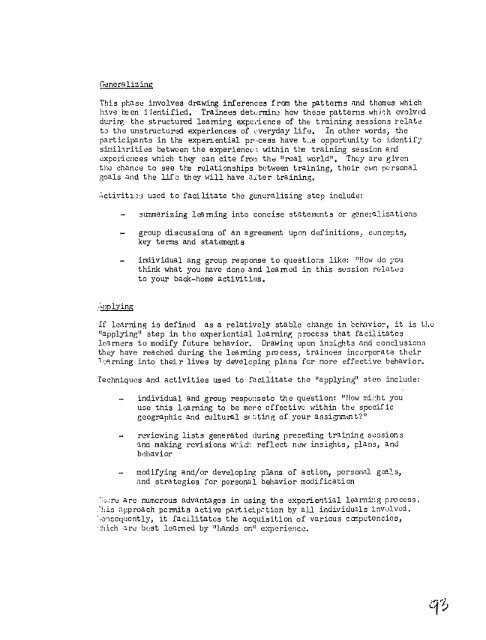Qn VATW Lk WAw LwUiWE WWW M - (PDF, 101 mb) - USAID
Qn VATW Lk WAw LwUiWE WWW M - (PDF, 101 mb) - USAID
Qn VATW Lk WAw LwUiWE WWW M - (PDF, 101 mb) - USAID
Create successful ePaper yourself
Turn your PDF publications into a flip-book with our unique Google optimized e-Paper software.
Genera! iz ing<br />
This phase involves drawing inferences frcm the patterns and themes which<br />
have been ilentified. Trainees deturmin- how these patterns whihh evolVwd<br />
duriT, the structured learnirg expo-'ience of the training sessions relate<br />
to the unstructured experiences of ..veryday life. In other words, the<br />
participants in the experiential pr-cess have t:.e opportunity to identify<br />
sLmilarities between the experience- within the training session and<br />
exper.nces which they can cite frou the "real world". They are given<br />
the chance to see the relationships between training, their own personal<br />
goals and the Lif a they will have after training.<br />
Activitia3 used to facilitate the generalizing step include:<br />
Aiplying<br />
- summarizing learning into concise statements or generalizations<br />
- group discussions of an agreement upon definitions, concepts,<br />
key terms and statements<br />
- individual ang group response to questions like: "How do you<br />
think what you have done and learned in this session relates<br />
to your back-home activities.<br />
If learning is defined as a relatively stable change in behavior, it is tUe<br />
"applying" step in the experiential learning process that facilitates<br />
learners to modify future behavior. Drawing upon insights and conclusionts<br />
they have reached during the learning process, trainees incorporate their<br />
a..rning into their lives by develcping plans for more effective behavior.<br />
Techniques and activities used to facilitate the "applying" sten include:<br />
- individual and group responseto the question: "How mi,-ht you<br />
use this lcarning to be more effectivw within the specific<br />
geographic and cultural se tting of your assignnt?"<br />
- reviewing lists generated during preceding training sessions<br />
and making revisions wl'i- reflect new insights, plans, and<br />
behavior<br />
- modifying and/or developing plans of action, personal goals,<br />
and strategies for personal behavior modification<br />
..,;ru are numerous advantages in using the experiential learni:g process.<br />
.'!is approach permits active participotion by all individuals involved.<br />
onse(uently, it facilitates the acquisition of various carputencics,<br />
:hich are b(;st learned by "hands on" experience.

















